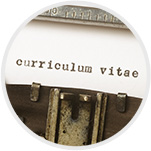CV (curriculum vitae, Latin for ‘course of life’)
You’ve found yourself a job you want to apply for, so now to get yourself an interview – with a sparkling CV.
Your CV should be a brief, factual account of your employment history and qualifications to date. It’s your opportunity to demonstrate you can clearly communicate what you have to offer an organisation. You also want to get over in your CV that you can do the job, that you have a good approach to work and that you will fit in with the company’s culture.
How to create a perfect CV
A CV can end up being a very dull, chronological list of your working life, so it’s important to be focused on what is relevant to the particular job for which you are applying. This will help you decide what goes into the document and in what order. A good approach is to organise your CV as follows:
- Name, address and contact telephone number
- Profile
Remember that the organisation or person you are targeting will have a number of CVs hitting their desk, so yours has to get the message across quickly. An eye-catching summary about yourself and your work experience will provide the reader with an idea of what you are looking for and will help your CV get noticed. - Skills
A summary of the skills you have acquired during your working life. - Employment history
Starting with the most recent job and then working backwards, list your career to date. Include the name of your employer, the start and end dates and your job title. Try and quantify your achievements where possible and show what you accomplished in each position. - Education
List the qualifications you have achieved and where you achieved them; school/college/university. - Personal Interests
List only those about which you are genuinely enthusiastic.
Your CV should also be tailored to the organisation you are targeting. This may involve only changing a small part of the CV, but it gives the impression that you have thought about the job for which you are applying.
Layout
Presentation is all-important. If you think about it, the easiest way for prospective employees to screen through a pile of CVs is to find reasons to reject them, so poor presentation will make yours an easy target. You should follow the golden rules:
Do:
- Use clear, simple language and avoid using jargon or clichés, eg ‘seasoned self-starter’.
- Use short, indented sentences in each part of the CV.
- Ensure it is fewer than two pages long.
- Ensure there are no spelling or grammatical errors.
- Make it attractive so that it differentiates you from the others without being too showy.
- Use good quality paper if you are printing it out.
One of the best ways of ensuring that your CV is perfect is to know what you should not do:
Don’t:
- Be boring and ramble on about trivialities.
- Be too sparse so that only the bare essentials are given.
- Have a disorganised layout.
- Make it difficult to read due to poor typing or photocopying.
- Enclose a photograph, unless specifically asked for one. Unfortunately some employers will pre-judge you on appearance.
- Give referees at this point. Wait until you are offered the job and select those people who will give you a reference appropriate to the position.
- Give salary details unless specifically requested. Some employers will use this to gauge whether you are suitable for the job.
- Be gimmicky, unless you are applying for a creative job where this might be more acceptable.
Covering Letter
People tend to draw a sigh of relief when they have completed their CV and are quite happy to post it off to their prospective employer without a cover note. This is a big mistake! You need to make an effort and write a relevant covering letter. If you think about it, your CV has taken a lot of effort, but it will be general and fairly formal, so this is your only chance to reflect your personality. Your covering letter should grab the reader’s attention and make them want to look at your CV.
Tips for the cover letter:
- Address it to an individual.
- Personalise your letter by explaining why you want to work for them and why you are applying for that particular position.
- Relate your CV to the vacancy by summarising the key points on your CV that fit the job for which you are applying.
- Keep the letter concise.
- Don’t fall into the trap of not sending a covering letter if you send your CV by e-mail.
Search thousands of jobs across Scotland with s1jobs.

